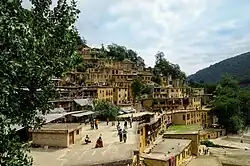Masuleh
Persian: ماسوله | |
|---|---|
City | |
 Masuleh view | |
 Masuleh | |
| Coordinates: 37°09′18″N 48°59′22″E / 37.15500°N 48.98944°E[1] | |
| Country | |
| Province | Gilan |
| District | Sardar-e Jangal |
| Population (2016)[2] | |
| • Total | 393 |
| Time zone | UTC+3:30 (IRST) |
Masuleh ⓘ (Persian: ماسوله, also Romanized as Māsūleh, Masoleh and Masouleh[3] is a city in Sardar-e Jangal District of Fuman County, Gilan province, Iran. Historical names for the city include Māsalar and Khortāb. It was founded in the 10th century AD.
At the 2006 census, its population was 554 in 180 households.[4] The following census in 2011 counted 568 people in 210 households.[5] The latest census in 2016 showed a population of 393 people in 147 households.[2]
Masuleh is approximately 60 km southwest of Rasht and 32 km west of Fuman. Its people are Talysh. The village is 1,050 meters above sea level in the Alborz (or Elburz) mountain range, near the southern coast of the Caspian Sea. The village itself has a difference in elevation of 100 meters.
Although it has been written that the community was established around 10 AD, the province of Gilan has a long history. The first village of Masuleh was established around 1006 AD, 6 km northwest of the current city, and it is called Old-Masuleh (Kohneh Masuleh in Persian). People moved from Old-Masuleh to the current city because of pestilence and attacks from neighbouring communities.
Masouheh-Rood-Khan is the river passing through the city, with a waterfall located just 200 meters away from the village. It's cut-off by snow during the winter months. Fog is the predominant weather feature of Masuleh.
Architecture
Buildings are mostly two stories (1st floor and 'ground' floor).
There are four main local communities at the city named: "Maza-var" (meaning beside the Mosque) at the south, "Khana-var" (beside homes) at the East, "Kasha-sar" (stretched on top) at the North, and, "Assa-mahala" (Assad community) at the West. Apparently, down town is the Market (Bazaar) area and also the main mosque of the city, named "O-ne-ben-ne Ali" (Awn Ibn Mohammad Ibn Ali Ibn. Abi Taleb) built in 969 AD.[6]
Girih tiling in buildings of Masuleh
_in_Traditional_Costume_-_Masouleh_-_Northwestern_Iran_-_02_(7420266658).jpg.webp)
Girih tiling consists of straight and broken lines on a regular basis that could be reasonably expanded in the surface.[7]
The historical city of Masuleh is a good model for sustainable architecture and its final aim is respecting the culture and friendly relationship with nature and improving the life style of its residents.[8]
Archaeology
Archaeological survey of the mountain ranges overlooking Masouleh shows that this mountainous region was probably occupied by ancient herders and nomads at least since the late Bronze Age.[9]
Remains of late prehistoric, historic, and Islamic times were discovered on the mountain top above 2500 meters above sea level(See). These mountains were used seasonally, at least since the late Neolithic (5000 BC) Bronze Age (2000-1500 BC), which continued during the Iron Age I (1500-1100 BC), Iron Age III (800-500 BC), Parthian (247 BC to 224 CE), Buyid (943–1029 CE), Seljuk (1043–1051 CE) and Ilkhanid (1306–1335 CE) periods(tehrantimes).
Archaeologists discovered pottery sherds, animal bones, and stone tools that date back to about 7,000 years ago. [10]
Tourism areas
Waterfalls: Kooshm, Larcheshme, and Kourbar.[11]
Masuleh also has its own beauties in winter.[12]
Gallery
 Window of building in Masuleh
Window of building in Masuleh The yard of the above building is the roof of the below building
The yard of the above building is the roof of the below building The nature of Masuleh
The nature of Masuleh Buildings are mostly 2 stories
Buildings are mostly 2 stories_006.jpg.webp)
Language
The native people of Masuleh speak Talysh.
See also
References
- ↑ OpenStreetMap contributors (3 October 2023). "Masuleh, Fuman County" (Map). OpenStreetMap. Retrieved 3 October 2023.
- 1 2 "Census of the Islamic Republic of Iran, 1395 (2016)". AMAR (in Persian). The Statistical Center of Iran. p. 01. Archived from the original (Excel) on 4 December 2020. Retrieved 19 December 2022.
- ↑ Masuleh can be found at GEOnet Names Server, at this link, by opening the Advanced Search box, entering "-3074349" in the "Unique Feature Id" form, and clicking on "Search Database".
- ↑ "Census of the Islamic Republic of Iran, 1385 (2006)". AMAR (in Persian). The Statistical Center of Iran. p. 01. Archived from the original (Excel) on 20 September 2011. Retrieved 25 September 2022.
- ↑ "Census of the Islamic Republic of Iran, 1390 (2011)". Syracuse University (in Persian). The Statistical Center of Iran. p. 01. Archived from the original (Excel) on 8 October 2023. Retrieved 19 December 2022.
- ↑ Sotoudeh, Manouchehr. "Monuments OF GĪLĀN". Encyclopædia Iranica. Retrieved 19 November 2011.
- ↑ Sattari Sarbangholi, H., & Hasanpour loumer, S. (2015). The Ornamentations of Girih Tiling in Buildings of the Khanebar Neighborhood in Masouleh. HONAR-HA-YE-ZIBA HONAR-HA-YE-TAJASSOMI, 19(4), autumn, 55-66.
- ↑ Hasanpour loumer, Saeid. "A Study on Decorations (Chinese Knotting) Used in Monuments of Masouleh Historical City, Case Study: Kasha-Sar Olia." the scientific-research degree of Armanshahr journal 9.17 (2017): 25-36. http://www.armanshahrjournal.com/article_44601.html. Web. 21 Apr. 2017. <http://www.armanshahrjournal.com/article_44601_d67ce62e2560b3fb2d9f0eac1aad57f8.pdf>.
- ↑ Biglari, F., M. Akbari 2022.L’homme et le paysage de montagne dans l’Elbourz, ARCHAEOLGIA, 608:16-17.
- ↑ "Discovery of 7K years old early herders' camp on Mountaintop near Masouleh, Gilan". 28 September 2022.
- ↑ "masuleh in iran". January 2019.
- ↑ "Winter attractions doubled the beauties of 'Masuleh City". iranpress.com. Retrieved 28 January 2021.
External links
- Masuleh Pictures
- HORIZIN, Masuleh, Photo Set, flikr
- Iran Cultural Heritage, Handicrafts and Tourism Organization:
- WiseItinerary
